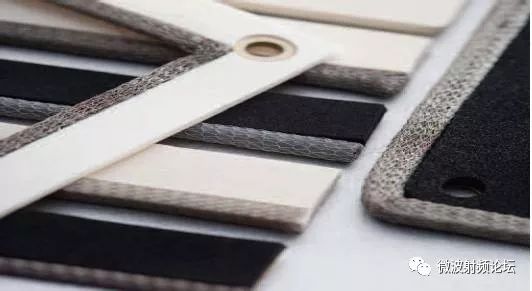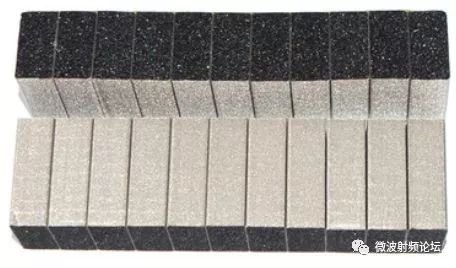The attenuation of electromagnetic waves passing through the shield is due to the loss of energy. This loss can be divided into two parts: reflection loss and absorption loss. Reflection loss: When electromagnetic waves are incident on the interfaces of different media, reflections occur, weakening the electromagnetic energy that passes through the interface. The loss of electromagnetic energy due to reflection phenomena is called reflection loss and is represented by the letter R. When the electromagnetic wave passes through a shield, it passes through two interfaces and two reflections occur. Therefore, the reflection loss when the electromagnetic wave passes through the shield is equal to the sum of the reflection losses at the two interfaces. The formula for the reflection loss is as follows:
R=20lg(ZW/ZS) (dB)
In the formula: ZW = wave impedance of incident electromagnetic wave, ZS = characteristic impedance of shielding material
|ZS|=3.68×10-7(fμrσr) 1/2 where: f= frequency of incident electromagnetic wave, μr=relative permeability, σr=relative conductivity
Absorption loss: When the electromagnetic wave propagates in the shielding material, part of the energy is converted into heat, resulting in loss of electromagnetic energy. This part of the lost energy becomes the absorption loss of the shielding material. It is represented by the letter A and is calculated as follows: A=3.34t ( Fμrσr)1/2 (dB)
Multiple reflection correction factor: When the electromagnetic wave is reflected at the second interface (the interface that passes through the shield) of the shield, it will be transmitted to the first interface again. At the first interface, it will reflect again and then reach the second position again. Interface, there will be a part of the energy penetration interface in this interface, leaking into space. This part is an extra leak. The calculation of shielding effectiveness should be considered. This is the multiple reflection correction factor, represented by the letter B. In most cases, B can be ignored.
SE = R + A + B

From the shielding effectiveness calculation formula given above, we can draw some conclusions that have practical guiding significance for the project. Based on these conclusions, we can decide what shielding materials to use and what problems to pay attention to. The conclusions given below, at first glance, will feel disorganized and unappealing, but after careful analysis in conjunction with clauses 3 and 4 above, you will find that these conclusions are intrinsically linked. In-depth understanding of the following conclusions is very important for structural design.
1) The better the electrical conductivity and magnetic conductivity of the material, the higher the shielding effectiveness, but the actual metal material can not take into account these two aspects, for example, the conductivity of copper is very good, but the magnetic permeability is very poor; the magnetic conductivity of iron is very good , but the conductivity is poor. What material should be used to determine whether to focus on conductivity or permeability, depending on whether the shielding depends mainly on reflection loss or absorption loss;
2) When the frequency is low, the absorption loss is very small, and the reflection loss is the main mechanism of shielding effectiveness, and the reflection loss should be increased as much as possible;
3) The reflection loss is related to the characteristics of the radiation source. For the electric field radiation source, the reflection loss is large; for the magnetic field radiation source, the reflection loss is small. Therefore, the shielding of the magnetic field radiation source mainly depends on the absorption loss of the material, so the material with higher magnetic permeability should be used as the shielding material.
4) The reflection loss is related to the distance from the shield to the radiation source. For the electric field radiation source, the closer the distance, the greater the reflection loss; for the magnetic field radiation source, the closer the distance is, the smaller the reflection loss is; and the correct judgement of the radiation source is correct. It is an important part of structural design to decide whether it should be close to the shield or the principle shield.
5) When the frequency is high, the absorption loss is the main shielding mechanism. At this time, it is not relevant to whether the radiation source is an electric field radiation source or a magnetic field radiation source.
6) The electric field wave is the easiest to shield, the plane wave is secondarily, and the magnetic field wave is the most difficult to shield. Especially low-frequency magnetic fields (below 1 KHz) are difficult to shield. For low-frequency magnetic fields, high-conductivity magnetic materials are used, and even high-conductivity materials and high-conductivity magnetic materials are combined.

Filter mesh refers to small aperture metal mesh or other materials with smaller apertures for a variety of different filtration, dust removal and separation requirements. They are widely used in shower panel, sanitary pipe systems, purifiers, electronic components, to remove contaminants or in applications, such as coffee machine, soya milk machine, to extract a filter cake. Because the metal mesh filters are one of the most durable filter media available, the material is mainly made of copper, iron, steel, nickel, stainless steel, alloy. It is acid resistant, alkali resistant, temperature resistant and wear resistant.
We customize diverse patterns metal microporous mesh with drawings provided by customers. We are equipped with professional metal etching equipment and exposure development equipment. Chemical metal etching filter mesh is a double-sided and simultaneous processing technology, which can make the product surface (positive and negative) smooth, without bumps, pits, burrs, warps, and flat mesh without deformation. Below are the advantages for customized metal filter mesh:
Flow Rate
One of the most significant advantages metal mesh has over most filter media used today is its ability to deliver an adequate flow rate. This is achievable as the wire diameter and mesh opening can be customized to perfectly match the contaminants you are filtering out, providing you with an enhanced level of filtration surface area.
Durability
300 series stainless steel is predominantly used. This helps create a filter that can withstand a wide range of impurities, pressure variations, and extreme temperatures without hindering the filter's accuracy. In addition, stainless steel is a very pliable material, allowing the filter to be formed to fit your filter system and hold its shape after several uses.
Accuracy
The weaving process used to construct mesh filters is heavily monitored from start to finish. As a result, the pore openings of the filter are exact and uniform throughout the filter. These precise pore opinings ensure that the end product, whether a filtered substance or a filter cake, is consistent and complies with industry standards.
Clean ability
As metal mesh features accurate pore openings, blinding and plugging are significantly reduced. This, combined with the enhanced flow rate, means system operators can clean the metal mesh easily. These two properties allow the mesh filter to be backflushed and purged of any unwanted debris with minimal pressure.
Metal Faucet Filter,Metal Coffee Filter,Metal Speaker Mesh,Customized Metal Filter Mesh
SHAOXING HUALI ELECTRONICS CO., LTD. , https://www.cnsxhuali.com